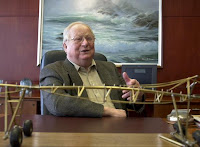 Flying across the USA everybody can observe center pivot irrigation: the cause for those green or brown circles or half-circles on the earth below. This type of crop watering system is very effective at creating valuable farmland out of previously unusable dry or even desert ground.
Flying across the USA everybody can observe center pivot irrigation: the cause for those green or brown circles or half-circles on the earth below. This type of crop watering system is very effective at creating valuable farmland out of previously unusable dry or even desert ground.These systems begin with a water source, usually in the center of a field. This source can be a well, canal, or other consistent water supply. From the water source, pipes or hoses allow the water to be transported along the entire length of a field. Wheeled towers allow the pivot to move slowly around the field.
Sprinkler heads spray or sprinkle the growing crops from the main pipe, or from drops that dangle below the structure just a few inches above the plants.
Two important benefits of pivot irrigation are that crops receive regular, consistent water, and that water evaporation and wind drift are greatly reduced. Besides, Pivot irrigation allows the farmer to determine how much water the plants receive, as well as how often the plants receive that water.
Water loss is minimized. In dry areas, water evaporation and wind drift can result in a major loss of water to crops. In the high plains where strong winds are common, wind drift can prevent water from reaching the plants on the ground. Also, warm dry air will cause water to evaporate at a much higher rate than other places.


